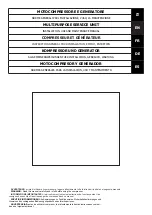
210.100-IOM (JUL 2021)
Page 29
AcuAir Hygienic Air Units
Installation
with all state and local codes and standard industry
practices.
There must be sufficient flexibility in the piping so that
any vibration from the unit is not transmitted to the
building and so that the piping joints at the unit are
not stressed. All refrigeration lines must be secured to
prevent wear or vibration at all operating conditions.
4.
Evaporator coils
– Evaporator coils are designed and
tested to a designated maximum allowable operating
pressure (PSIG). It is the contractor’s and/or customer’s
responsibility to provide controls and reliefs within the
refrigeration system to prevent internal pressures from
becoming higher than the tested operating pressure.
CAUTION
Halocarbon refrigeration coils may not have been
fully evacuated or totally dried at the factory. It is
the customer’s/contractor’s responsibility to pro
-
vide adequate evacuation of the evaporator coil and
ensure that the coil is dry and water free before
start-up of the system.
5.
Water or brine coils
– It is essential that the piping for
the system be done so that all lines can be drained and
there are no traps or pockets on the system where wa-
ter or brine can collect and freeze. Pitch all piping away
from the unit coil. Install the piping in a manner that
allows the coil to be filled with a solution to prevent
freezing, if necessary.
Duct connections
Make duct connections to the casing by screwing
flanged
ducts directly to the casing with self-tapping sheet metal
screws.
Duct connections to collar-type openings can be made
with S cleats or overlapping joints.
Apply polyurethane caulking around the duct connection.
It is important to seal all duct connections to prevent air-
leakage and system performance problems.
Frick suggests that all duct connections to the AcuAir
®
unit
be insulated to minimize condensation.
Figure 33: Detail of duct connection
CAULKING
SHEET METAL SCREW
DUCT
Figure 34: Connection of duct
















































